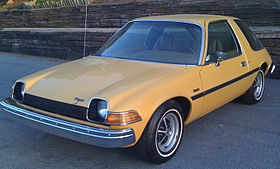| AMC Pacer | |
|---|---|
 | |
| Overview | |
| Manufacturer | American Motors Corporation (AMC) |
| Also called | VAM Pacer (Mexico)[1] |
| Production | 1975 – 3 December 1979[2] |
| Model years | 1975–1980 |
| Assembly | Kenosha, Wisconsin, United States Mexico City, Mexico (VAM) |
| Designer | Dick Teague |
| Body and chassis | |
| Class | Compact car |
| Body style | 2-door hatchback coupe 2-door station wagon |
| Layout | FR layout |
| Powertrain | |
| Engine | 232 cu in (3.8 L) I6 258 cu in (4.2 L) I6 282 cu in (4.6 L) I6 (Mexico only) 304 cu in (5.0 L) V8 |
| Transmission | 3-speed manual 3-speed with overdrive 4-speed manual 3-speed automatic |
| Dimensions | |
| Wheelbase | 100.0 in (2,540 mm) |
| Length | 171.8 in (4,364 mm) (coupe) 176.8 in (4,491 mm) (wagon) |
| Width | 77.3 in (1,963 mm) |
| Height | 52.8 in (1,341 mm) (coupe) |
| Curb weight | 3,000 lb (1,361 kg) |
The AMC Pacer is a two-door compact car produced in the United States by American Motors Corporation (AMC) from 1975 through the 1980 model year. The Pacer was also made in Mexico by Vehículos Automotores Mexicanos (VAM) from 1976 until 1979 and positioned as a premium-priced luxury car.
Design work began in 1971. The rounded shape and large glass area were unusual compared with the three-box designs of the era.[3] The Pacer's width is equal to full-sized domestic vehicles at the time, and AMC promoted this unique design feature as "the first wide small car".[4] The Pacer was the first modern, mass-produced, U.S. automobile design using the cab forward concept.[5][6][7]
Upon its introduction, reviews used descriptions such as "futuristic, bold, and unique".[8] The Pacer featured an aerodynamic "jellybean" styling, numerous innovations such as different door lengths.[9] This was noted "as a space-efficient car, seemingly from the future".[10][11] The Pacer stood out at a time when "Detroit was still rolling out boat-sized gas guzzlers."[12]
- ^ "VAM Pacer advertisement". motorstown.com. Archived from the original on 16 February 2020. Retrieved 31 December 2022.
- ^ "Last AMC Pacer rolls off assembly line". History. A&E Television Networks. 1 December 2020. Retrieved 17 August 2021.
- ^ Gartman, David (1994). Auto opium: a social history of American automobile design. Routledge. p. 216. ISBN 9780415105712. Retrieved 31 December 2022 – via Google Books.
- ^ "AMC Pacer Statistics and Fun Facts". The Pacer Page. Archived from the original on 4 August 2021. Retrieved 31 December 2022.
- ^ Driscoll, Mike (November 2003). "The pylon points to: Mindi Cross". The Pylon Press. Archived from the original on 16 February 2012. Retrieved 31 December 2022.
- ^ Stakes, Eddie. "Response to the posting of Matt Crawford's "Why a Pacer?" essay, "Did the Pacer kill AMC?"". AMC Pacer Page. Archived from the original on 16 October 2021. Retrieved 31 December 2022.
- ^ Peter, Eric (2004). Automotive Atrocities: The Cars We Love to Hate. MotorBooks. p. 54. ISBN 9780760317877.
- ^ Peek, Jeff (3 December 2019). "Love it or hate it, the AMC Pacer is an automotive legend". Hagerty. Retrieved 22 May 2022.
- ^ Hinckley, James; Robinson, Jon G. (2005). The Big Book of Car Culture: The Armchair Guide to Automotive Americana. MBI Publishing. p. 122. ISBN 9780760319659. Retrieved 31 December 2022.
- ^ Joe Ligo: The Unfortunate History of the AMC Pacer on YouTube, 2013
- ^ Shea, Terry (17 January 2020). "This AMC Pacer just sold for a near-record price on Hemmings Auctions". Hemmings. Retrieved 31 December 2022.
- ^ Gallant-Stokes, Trudy (November 1988). "Designs on the Future". Black Enterprise. Vol. 19, no. 4. p. 52. Retrieved 31 December 2022 – via Google Books.